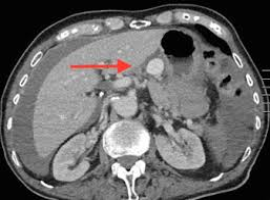Louise Dunphy*, Syed Hussain Abbas and Gisella Salerno
Department of Surgery, Wexham Park Hospital, UK
*Corresponding author: Louise Dunphy, Department of Surgery, Wexham Park Hospital, Slough, UK, E-mail: Louise.Dunphy@doctors.org.uk
Received: October 21, 2019; Accepted: November 04, 2019; Published: November 11, 2019
Citation: Louise Dunphy, Syed Hussain Abbas, Gisella Salerno, et al. Endovascular Management of a Gastric Artery Aneurysm Rupture. Clin Image Case Rep J. 2019; 1(2): 106.


